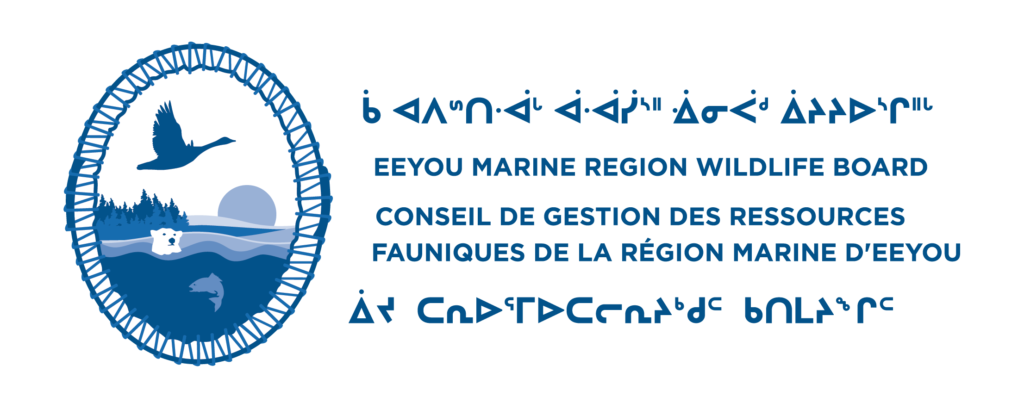Polar Bear Ecology in the Eeyou Marine Region
RESEARCH LEAD: Alexandra Langwieder (McGill University), Murray Humphries (McGill University)
DURATION: 2021-2024
AMOUNT AWARDED: $47,715 (2024-2025)
In recent consultations, communities in the EMR identified the need to gather more information on polar bears in the region. Polar bears are important predators in arctic and sub-arctic systems and their population structure and distribution across the landscape can have impacts on other species and human communities. Globally, polar bears are threatened by reduced sea ice habitat and increased fasting periods associated with climate change. As the most southerly polar bear population in the world, polar bears in James Bay are particularly vulnerable to warming temperatures and sea ice losses. Polar bears in James Bay are managed through the Southern Hudson Bay management unit which extends from the Ontario-Manitoba border across to Nunavik (Quebec). Previous studies of the bears in the Southern Hudson Bay management unit have focused on polar bear movement on the sea ice, population abundance, and body condition related to sea ice decline, but little is known about polar bear ecology in James Bay.
Recent evidence suggests that James Bay polar bears may be genetically distinct from the Southern Hudson Bay polar bears and demonstrate unique behaviours. In one study, polar bears captured on Akimiski Island showed significantly different movement patterns than bears captured on the Ontario Hudson Bay coast, remaining almost entirely within James Bay compared to the far-ranging movements of bears captured on the Ontario Hudson Bay coast. Understanding James Bay polar bear ecology and their possible distinction from the Southern Hudson Bay management unit is important for making appropriate polar bear management decisions in James Bay and the EMR.

Understanding James Bay polar bear ecology and their possible distinction from the Southern Hudson Bay management unit is important for making appropriate polar bear management decisions in James Bay and the EMR.
We started this project as a collaborative effort from the EMWB, Cree Trappers’ Association, communities of Waskaganish, Eastmain, Wemindji and Chisasibi, and McGill University based on the needs and research questions expressed by community members. Our objectives are to:
1) Establish community-based polar bear monitoring using non-invasive methods that respect Cree ethical values
2) Answer questions about the James Bay polar bear diet, habitat use, and body condition with Cree Knowledge and field techniques (hair snares and camera trap sampling stations)
3) Determine the genetic distinction of James Bay bears from the Southern Hudson Bay subpopulation
For more information about the beginnings of the project, you can find our paper published here.


COMMUNITY PROJECT LEADS:
Waskaganish: Sanford Diamond, Harry Erless, Bernard Diamond, Stephanie Salt, Dwayne Weistche, Anderson Jolly
Eastmain: Wilfred Cheezo, Dylan Mayappo
Wemindji: George Natawapineskum, Henry Stewart, Ernie Hughboy, Cody Mark
Chisasibi: John Lameboy, Steven Bobbish, Irvin Matches
RESULTS:
Over three field seasons from 2021 to 2023, community teams collected over 300 hair samples and hundreds of polar bear observations. Polar bears were found in mostly average body condition in 2021, and in mostly fat body condition in 2022 and 2023. Bears were detected primarily on the offshore islands, with clear areas of high activity on islands in Waskaganish territory and the Twin Islands in the center of the bay. Forest fires prevented fieldwork on the Twin Islands in 2023.
Over 25 community members have been involved in the two month summer field season, with most teams returning to lead work every year.



Through genetic analysis of the hair samples, we have identified 62 individuals (32 males and 30 females) in the study to date. The next step of this work will determine how these EMR bears are genetically related to other bears in the Southern Hudson Bay management unit.

UPCOMING WORK:
Teams will continue to deploy hair snare and camera trap sampling stations across the EMR in summer 2024. Hair samples from the project will be used to determine polar bear diet in James Bay through stable isotopes in hair that reveal what a bear has been feeding on while the hair was growing. Alexandra will be undertaking a series of Cree Knowledge interviews in each of the coastal communities to understand the seasonal patters, diet, and behaviour of this polar bear population and how these may have changed over time.
In 2024, the project expanded to Whapmagoostui and Kuujjuarapik in eastern Hudson Bay based on interest from the communities and the need to understand how bears may be moving between James and Hudson Bay. This work will be led locally by Robert Fireman and Raymond Mickpegak.
PAST UPDATES:
PHOTOS FROM THE FIELD:




















Photo credits by Alexandra Langwieder, Félix Boulanger and Harry Erless


